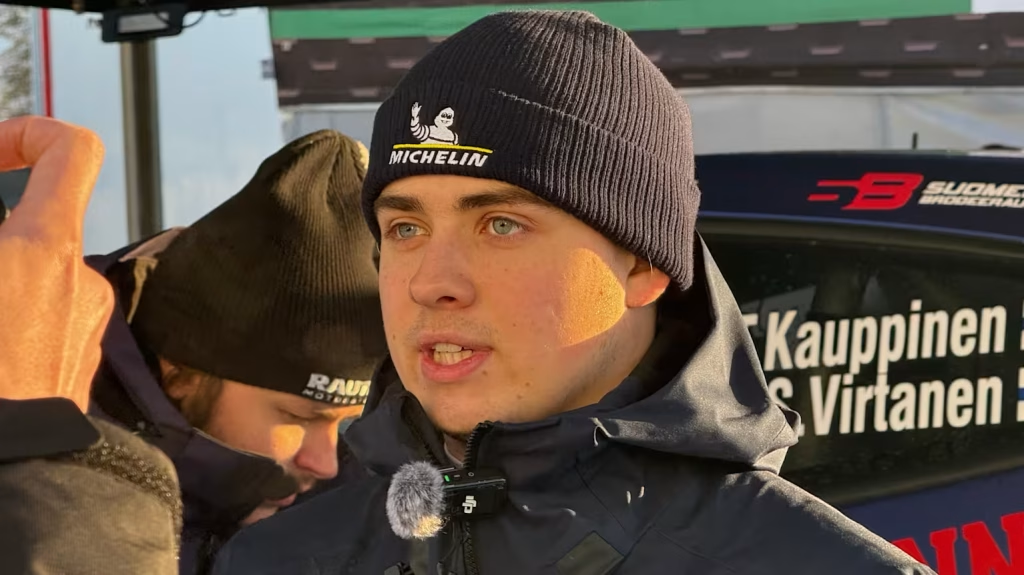In a surprising turn of events at the Arctic Lapland Rally, a significant result unfolded as 18-year-old Tuukka Kauppinen triumphed over two-time world champion Kalle Rovanperä, finishing with a time that was 11 seconds quicker than his more experienced rival. The rally, which took place in Rovaniemi, showcased Kauppinen’s remarkable talent and ability to navigate the challenging winter conditions.

Kauppinen’s performance throughout the event was nothing short of exceptional. Piloting a Toyota GR Yaris Rally2, he delivered a flawless run, maintaining a steady grip on the road and displaying incredible skill. Over the course of the two-day rally, Kauppinen found himself only once outside the top three for stage times during the 13 assessments, establishing himself as a formidable competitor.
A critical factor contributing to Kauppinen’s success lay in the specifics of rally equipment used by him and Rovanperä. For winter rallies like this one, the length of the studs on tires plays a crucial role in performance. The Finnish Rally Championship regulations permit tire studs to extend up to nine millimeters, and Kauppinen was fully utilizing this limit. Rovanperä, racing with World Rally Championship regulations, was equipped with tires that had studs protruding only by seven millimeters. Despite Rovanperä enjoying the horsepower advantage of 100 extra horses from his Rally1 vehicle and superior aerodynamic capabilities crucial for high-speed sections, the physics of Kauppinen’s superior grip on the icy surface proved decisive.
Moreover, the context of the race for Rovanperä involved a considerable amount of experimentation with new tires from Hankook. As he aimed to acclimatize to the snow conditions, Rovanperä characterized the event as a practice session, focused on optimizing the car setup and finding the best strategies for performance. He reflected positively on his experience, noting the importance of evaluating the vehicle’s behavior, especially in relation to the new tire design.

Rovanperä’s strong finish in second, despite the loss, is indicative of his focus on preparation for future competitions, particularly the upcoming event in Umeå. He regarded the rally as a valuable opportunity to gain insights into the car’s handling and its overall performance in snowy conditions. Rovanperä’s calm approach illustrated his understanding that racing, like all sports, carries lessons that contribute to overall mastery of the craft.
The rally also saw the return of another Toyota legend, Jari-Matti Latvala, who debuted his Celica Turbo 4WD. Although he faced technical difficulties near the end of the competition, which reduced his car to three functioning cylinders for the final stage, Latvala was visibly pleased with his vehicle’s performance. He appreciated the thrill of pushing the older model close to contemporary cars, indicating the excitement and nostalgia that competitions like these bring to the sport.
As Latvala transitioned from driver’s seat to team principal, he launched into discussions with Rovanperä throughout the rally, offering insights and guiding his protégé on car performance improvements. Their communication was vital, especially for Rovanperä, to analyze setups and understand where they could improve for upcoming rallies. Latvala’s expectation for Rovanperä was that this event would allow him to gather knowledge about tire behavior in varying conditions, thus better preparing him for the challenges ahead.

When addressing the rally’s outcome, Latvala acknowledged the variations in tire technology between national and world championship levels. The differences in the tire regulations do affect performance and times achieved, clearly visible during the event. Rovanperä’s experience in the Finnish championship not only helped him understand his car’s potential but also fostered a deeper appreciation for the competitive nature of the sport at different levels.
Latvala’s experience during the rally underscored the essential development process inherent in motorsport. The rally served as a platform for evaluating tire performance under different conditions, paving the way for crucial strategic decisions to be made ahead of competitive seasons. This knowledge acquisition proved as vital as any mechanical improvement, and the evaluation of product performance will be instrumental for the team in utilizing new tire technology effectively.
As Kauppinen celebrated his well-deserved victory amidst the snowy landscape of Rovaniemi, it became clear that this event was not just a test of speed but also a revelation of talent and potential for the next generation of rally drivers. Kauppinen’s remarkable achievement added a new layer of excitement to the Finnish rally scene, demonstrating that up-and-coming drivers could challenge the established stars like Rovanperä, creating a more dynamic competitive environment.



